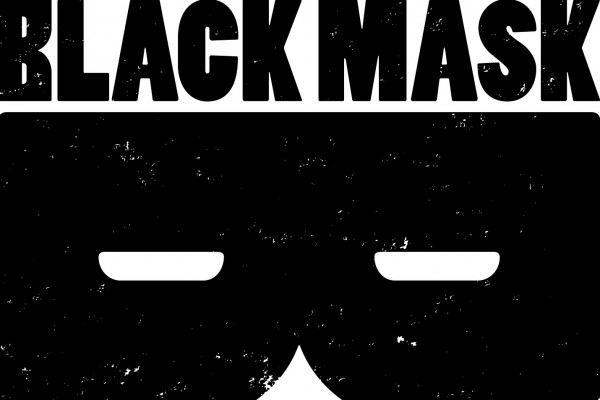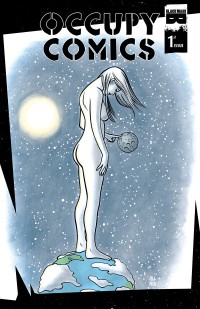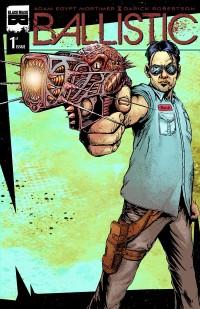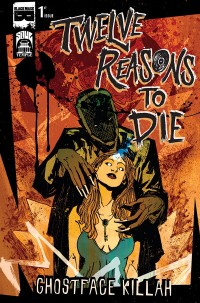
Steve Niles and Matt Pizzolo grew up in the east coast hardcore scene, but never outgrew what they learned from it. Previously of Gray Matter and Three, Niles has established himself as one of the most respected writers in contemporary comics. He is best known for his horror work, including 30 Days of Night, Criminal Macabre and Edge of Doom. Pizzolo is the founder of Halo 8 Entertainment, putting out a mix of film, comics and transmedia works, including Your Mommy Kills Animals, N.Y.H.C. and Pizzolo's own Godkiller.
The pair recently launched a hugely successful Kickstarter campaign for their Occupy Comics initiative, and have teamed up with Epitaph Records boss Brett Gurewitz to form Black Mask Studios, a comics publisher seeking to combine the expertise of the three into a new outlet for interesting creators.
Andy Waterfield sat down with Steve and Matt to talk about Occupy, the birth of Black Mask, practical applications of the DIY ethic and why the comics industry needs some fresh thinking.
How did Occupy Comics come about, and how did that lead to the creation of Black Mask Studios? Matt: It was right after the protesters had moved into Zuccotti Park, and it wasnât getting a lot of press attention. I had the idea that we should do something at New York Comic Con that would draw attention to what was happening, and maybe inspire some people to go down there, and check it out or participate. Steve was one of the first people I reached out to because he also has a background in activism, and in the punk scene.
 The original, core team was maybe half a dozen comics pros, and the idea was that we were gonna do a really quick comic zine, to get out at NYCC, to spread the word about what was happening. In the interim, the police started pepper spraying the girls, there was the Anthony Bologna thing and it became a media firestorm. There was no longer a need for exposure; it became more about, well, how do we constructively support whatâs happening, but also try and cut through the haze of the media representation?
The original, core team was maybe half a dozen comics pros, and the idea was that we were gonna do a really quick comic zine, to get out at NYCC, to spread the word about what was happening. In the interim, the police started pepper spraying the girls, there was the Anthony Bologna thing and it became a media firestorm. There was no longer a need for exposure; it became more about, well, how do we constructively support whatâs happening, but also try and cut through the haze of the media representation?
The idea became to do it as a fundraiser, because with winter coming there was a real concern about the protesters and how they were going to stay there. We were trying to raise money for space heaters, sleeping bags, honey wagons and stuff like that. That was the core, immediate goal of it, and the longer term goal was to create a time capsule of what was occurring, through the lens of the different artists, because art had so much to do with rallying people in the first place. If you look at what drove the initial round of protesters there, it was a lot of posters, paintings, and different artistic works. What was driving them there wasnât so much an intellectual manifesto, so we thought it should also be recorded by artists, and then the time capsule thing became really important.
The whole thing snowballed from there, but by the time we had finished the Kickstarter the parks had been cleared. Again, we needed to pivot a little, look at the resources we had, and [figure out] how we could be helpful, so we decided we were going to do more broad distribution of the book. The way itâs structured is that each of the creators has the right to assign where their share of the money goes, so itâs a coalition. Itâs not something where I, Steve or anybody else decides. Everyone can pool their money together, but they all control their own share of it, so I canât say specifically where the money will ultimately go, but I know thereâs a lot of interest in the initiatives that are happening now, like Strike Debt, Rolling Jubilee, and the different rescue projects. Because it became less about sleeping bags, and more about supporting larger initiatives, we felt like we needed a pipeline to get the book out more broadly, and [from that] we had the idea to form Black Mask Studios.
Brett Gurewitz, from Epitaph Records and Bad Religion, had backed the Kickstarter for Occupy Comics, and he was really engaged in it during the whole process. When we were looking around for deals, we talked to every single comics publisher. The deals they offer for a Kickstarted project are pretty draconian, so we were really disappointed in the offers we were getting. It wasnât like we were a little Kickstarter, and the deals we were getting were really terrible, so I canât even imagine what it must be like if you have a personal project you put out on Kickstarter.
We were really frustrated by that, so Brett had suggested building an infrastructure on the back of some of the infrastructure he already has in place with Epitaph. That became the kernel of the idea behind Black Mask, because we figured if we were gonna build the pipeline for Occupy Comics, then we might as well build it to last, and use it to support other creators.
 Steve: I think the fact that it didnât work out with the other publishers was actually a blessing in disguise. We'd always been talking about trying to find new readers. Working with Epitaph and Brett is much riskier, but itâs much more what we need, trying to find new readers to read comics. Not just trying to convince people from the outside to read superhero comics, but showing people that thereâs more you can do with words and pictures than just guys in their pajamas beating each other up. Thereâs a lot more that can be done.
Steve: I think the fact that it didnât work out with the other publishers was actually a blessing in disguise. We'd always been talking about trying to find new readers. Working with Epitaph and Brett is much riskier, but itâs much more what we need, trying to find new readers to read comics. Not just trying to convince people from the outside to read superhero comics, but showing people that thereâs more you can do with words and pictures than just guys in their pajamas beating each other up. Thereâs a lot more that can be done.
I think itâs really worked out much better for us. Itâs a big experiment. Weâre gonna see if there is that outside interest in comics. Iâm actually kind of happy we didnât get any of those deals, because that would have been the same way Iâve done comics for almost thirty years now, under that model. Iâm really excited about Black Mask and working with Epitaph, because weâre gonna have that chance to get different books in front of new readers. Thatâs the most exciting part for me.
Matt: Steve and I met on a horror panel at San Diego Comic-Con…
Steve: You were making fun of vampires, I think.
Matt: I did make fun of vampires, Steve came at me, and I was like, "No, dude! I like your vampires!" [Laughs.]
But, one of the things we got to talking about early on, the obvious example is 30 Days of Night; various of Steve's books have crossed over outside of the âDirect Marketâ core comics fan, and so some have sold in the hundreds of thousands of copies. Iâm sort of an outsider to the comics world, and I did this project called Godkiller, which was a comic but it was also transmedia. Itâs such an annoying marketing buzzword, but when I say âtransmediaâ I just mean storytelling across multiple platforms.
So, Godkiller was this multi-platform fantasy story that tapped into other audiences, and also reached people well into the hundreds of thousands. And weâre on this panel where everyoneâs talking about how an independent comic these days is selling, at best, 5,000 to 25,000. The Walking Dead peaks at around 35,000, unless itâs an event issue with a hundred different variants or whatever. Steve and I were having this conversation when we know that there is an audience there. We love the comics fans and the comic shops, and we donât wanna cut them out, but you canât limit it to that; and you really have to do outreach to get to the people who are ready and willing to support really interesting, different stuff, and theyâre just not being reached. Steve and I both knew the audience was there, ready for it, so we wanted to work together to reach them.
Steve: Are you familiar with how the comic market works and the distribution as opposed to, like, music distribution?
With Diamond (Diamond Comic Distributors Inc.) basically having a monopoly? Steve: Exactly! Imagine if you could only get music through licensed dealers. Youâve basically got 2,000 stores, and of those stores, under the Diamond system, only 90 tend to buy independents, so indie artists in comics are forced to try to make a living off of 90 retailers, essentially.
Which is just… yâknow… I canât believe Iâm still alive, to tell you the truth.
Matt: Marvel gets their own book, but in the front of the Previews catalogue, where everyone orders their books from, you have DC, Dark Horse, Image and IDW. Thatâs the front of the book; it looks really nice, and they have full pages; and then thereâs the back of the book, and it looks like the classified section of a newspaper, or an old phone book or something. Thatâs the listings for everybody else. Itâs really hard to get any traction if youâre not at the front of the book, to the point where, now, those front of the book publishers, theyâre letting people pay to publish in their section of the book. So, youâre basically paying, as an independent creator, to one of those premier publishers, a fee so you can be in the front of the book, when youâre still paying for all of your own production. In a lot of cases they wind up owing them money.
So, itâs this crazy thing where you can self-publish in the back of the book, or you can pay extra to self-publish in the front of the book. Weâre gonna be the punk rock company, weâre gonna be in the back of the book.
And none of thatâs a guarantee that the shops are gonna get enough pre-orders that theyâll order the book in the first place. Steve: Exactly, and thatâs the challenge. Nothing against Diamond, nothing against retailers. I donât envy what retailers are up against every month. Theyâve got a certain budget, theyâve got DC and Marvel flooding the market with not just books, but variant covers on the same books, so theyâre actually trying to get people to buy the same book twenty times, and itâs working. So, once they get through DC, Marvel, Image, IDW and Dark Horse, with whatever energy and money they have left, they have to pick from the back of the book. Itâs a really tough market right now, and that system just makes it a little harder.
 Matt: Steve knows this better than I do, but I was working at St. Markâs Comics in New York, right before Diamond became the monopoly, when there were three different distributors, and at the time it was structured differently. You had everybody alphabetised, and thatâs when you had this really amazing resurgence of the really cool early â90s comics, where there were the underground comics and the outlaw comics, and the black & white explosion. Image came on the scene at that time.
Matt: Steve knows this better than I do, but I was working at St. Markâs Comics in New York, right before Diamond became the monopoly, when there were three different distributors, and at the time it was structured differently. You had everybody alphabetised, and thatâs when you had this really amazing resurgence of the really cool early â90s comics, where there were the underground comics and the outlaw comics, and the black & white explosion. Image came on the scene at that time.
Itâs interesting how many more books were being sold, different types of books, and it wasnât just superheroes and reboots. People were really being experimental, and it really had that punk spirit, and the DIY spirit to it, where people were self-publishing their own stuff, and finding a lot of success.
I think what Steve and I are both hoping is that, through using different technology, and social outreach; engaging with the comic book stores, but also finding new ways to reach the audiences; we can try and rekindle some of that spirit.
Steve: For me, the big change for comic distribution was when the direct market started. I grew up in the â70s, when there was still newsstand distribution. You could go anywhere, and there would be a spinner rack. Essentially, what wound up happening was the direct market turned into only comic stores carrying comics, and one by one they gobbled each other up. Weâve had decades watching this happening, and nobodyâs tried to do anything different.
Matt: Itâs interesting, Steveâs point about the spinner racks. When I was a kid, I discovered my first comic book when my dad was buying a newspaper. They were set up on the floor, or at kid level, so I was like three years old and picked up a copy of Defenders, and that gets you into it! Now you get comics by going into a comic book store, so you need to already be a fan.
Steve: Plus, it has to be a premeditated move, as opposed to when we were kids. For me, I was being dragged around by my mom and sisters, always shopping and stuff, so seeing those spinner racks was kind of my savior.
And now, itâs strange because theyâre using the merchandise and trying to backwards market. "Well, if they go and see the Avengers movie, maybe theyâll buy the comic?" Theyâre not buying the comic; itâs not translating.
Matt: The readership is mostly guys in their 30s, 40s and 50s, who grew up with spinner racks. Itâs maintained that same audience, itâs just not bringing in new readers, so thereâs this really weird attrition rate to it, and everyoneâs stunned that their circulation is dropping.
I had this funny experience, because the way that Godkiller came out, its core audience is high school and college-aged girls which is obviously the antithesis of who is generally reading comics. So, whenever I look at Facebook stats and Google Analytics, the demographic split is really broad for all my Godkiller stuff, and Iâll see certain spikes, like [from] kids who go to art school.
Then, when we did the press release about the company, about Black Mask, a couple weeks ago, it got picked up in all the comics press, and I was looking at the demographics coming in after that, and it skewed completely into males in their late 30s and 40s! Itâs amazing how much comics are speaking to a very, very, very specific audience. I mean, Iâm in that demographic; itâs not like I donât want to tell stories for that audience, but itâs just so specific, and it just doesnât break out of there at all, so thatâs one of the goals that we have, to reach more broadly.
Steve: No other medium suffers like this. Imagine if CDs only sold 5,000… top 100,000. Are you telling me people donât like music? Weâre trying to convince people that we even exist, let alone trying to sell them some books.
How do you feel your roots in punk and hardcore, and the various independent media project that youâve been involved with, inform what youâre doing with Black Mask? Steve: I grew up in the DC scene, with the Dischord guys and all that. We folded our own posters, put together our own shows, booked our own tours, put out our own albums, did everything ourselves, so it just makes sense to do it this way.
How to say this without trashing people… [Laughs.] I just believe that you can do business without stepping on the next guy. I really think you can get ahead without screwing other people over. To me, thatâs the main punk rock ethic I grew up with, and thatâs the kind of business model I wanna try.
I watched Dischord become millionaires, $5 at a time, despite themselves. It was kind of funny watching that happen, because nobody really wanted the money, so they just wound up turning it around and putting it back into other projects, which is what Iâm interested in.
That whole DIY, not-fucking-over-the-next-guy ethic is a big part of the way I like to do business. Iâm trying to bring that with me, and also… just mixing it up, not being afraid of change, and doing something different. Itâs amazing to me how frightened people are of trying anything new, and Iâm kind of excited by the idea. I have no idea if any of this stuff is gonna stick, but I love the challenge. Itâs not like when we were sitting around playing in bands we were worried we were gonna get picked up by record labels! That was the last thing on our minds. We enjoyed what we were doing, and in turn other people enjoyed it. Iâm just trying to apply that same sort of ethic to comic books.
 Matt: The term âpunkâ gets tossed around a lot, but I think for both of us itâs really the âDIYâ aspect of the punk scene that informs a lot of what weâre doing. Itâs different, because everybody else is trying to figure out how to get their books into Walmart, and we donât come from there; we come from figuring out how to reach an audience thatâs gonna be really excited about it, champion it and do it from the grassroots up. To me, itâs more about finding new places to reach out to people. We want to support the comic book shops, but we also want to work with record stores, info shops, anarchist bookstores and stuff like that; the kinds of places where people go and look for new ideas.
Matt: The term âpunkâ gets tossed around a lot, but I think for both of us itâs really the âDIYâ aspect of the punk scene that informs a lot of what weâre doing. Itâs different, because everybody else is trying to figure out how to get their books into Walmart, and we donât come from there; we come from figuring out how to reach an audience thatâs gonna be really excited about it, champion it and do it from the grassroots up. To me, itâs more about finding new places to reach out to people. We want to support the comic book shops, but we also want to work with record stores, info shops, anarchist bookstores and stuff like that; the kinds of places where people go and look for new ideas.
If you look at our slate, the stuff that weâre doing is really unique, and thereâs a certain amount of activism. Two of the projects that weâre starting with are fundraising for activist goals; Liberator has 30% of the money going to dog rescues, and with Occupy all the profits are being donated.
When youâre coming from something with a DIY ethos, the passion to do all that extra work comes from it being something that you believe is important, on another level than just basic entertainment. I think weâre comfortable with a broader range of topics than most comic publishers are going to be interested in doing.
The other thing thatâs really funny; I used to say to people that being from the hardcore scene is a little bit like either being a freemason, or in a frat. You always hear from people, "I had this meeting, and it turned out the guy was a fraternity brother, and as a result I got hooked up," and Iâm like, "Really? God, that sucks." But then, Iâve always found that Iâll go into a meeting, thinking, "I donât know why Iâm even meeting with this store chain. Theyâre in a mall, theyâre not gonna get it." And Iâll walk into the meeting, and the guy running the meeting is from the scene; a tattooed guy who knows all the same stuff, has the same background, and the same sensibility. Itâs crazy how that happens.
Steve, youâve been extremely vocal in your support for creatorâs rights over the years. How have those ideals shaped the way Black Mask works with its creators? Steve: Well, I think itâs really important that creators maintain their rights, but more than anythingâand I think this is where people get a little crazy about IP, and wind up holding on too tightlyâI donât want to hear any more stories like Jack Kirby or the Shusters, or… Unfortunately, I could go on and on, with both DC and Marvel creators over the years, who didnât know what rights were, and as a result wound up losing everything. The fact that the Shusters donât see a dime from anything Superman is just a sin. Jack Kirby… Every movie weâre seeing coming out is because of that man, and I think the fact his family doesnât see anything is really terrible.
More than anything, what I try and advocate most is, just be aware of what your rights are. For myself, Iâm perfectly aware that when I go to DC, and I write a Batman story or a Spectre story, anything I create is theirs. I signed a work for hire contract, so itâs theirs, but I know that going in. A lot of creators just donât know what their rights are.
For someone like me, as an independent creator, those auxiliary rights; selling stuff for movies or TV or what have you have been one way I can actually make some money off of this stuff. Again, itâs not just about huddling in the corner, protecting yourself and never doing anything with it. Educate yourself, know what youâre getting into and understand the realities of it, because unfortunately comics has a 70+ year history of basically ripping off every creator whoâs ever walked in the door. Most of that is just because people didnât know.
I donât even know if people realise, but before Neal Adams fought, no artist got their art returned to them, so whatever page rate they got, that was it! They drew it, they sent it in, and then the publishers would often times make quite a bit of money off that original art. Neal Adams stood up and said, "Wait a second! You are paying us for the right to print, not the right to own that original piece of art," and that little fight alone shifting the way artists function in this industry. A lot of artists, their main income is not doing the comic for the crappy little page rate; itâs being able to sell the artwork after the fact.
What it is really comes down to is, be aware of what your rights are but donât be crazy, and hopefully we can avoid more of these sad stories. And also, donât feel like you always have to sit and wait for somebody to accept your story. Go do it yourself! If youâve spent ten years pitching Marvel, and theyâre not taking your stories, thatâs ten wasted years you could have been doing something else.
Matt: One of the other things Steve, Brett and I are doing with the creators, is to be there to help them navigate some of the process of taking their intellectual property outside the comics space. You have a situation now where, in order for comics to reach the larger audiences that they need to, most of the heavy lifting on the marketing is being done by Hollywood companies. The Walking Dead wasnât selling those numbers until AMC started marketing it.
Because there has been this bubble, and this real push for comics to get turned into everything else, creators actually have a need to have that occur on some level, but itâs really hard to do it. In some cases, publishers are saying "Come to us. Weâre not going to give you any money, but youâll get to keep all your rights." Itâs used as this carrot where it seems like this amazing deal, but youâre also not getting any help. What happens is, either they donât do anything with the rights, or they get taken advantage of because they donât have anyone who can help them navigate that side of things, because itâs a whole other business! Weâre there to support the creators however they need help. If they donât need help with that side of it, then they donât need us there, but we are there when they do.
 Youâve talked before about offering an outlet for stories other publishers might shy away from. Could you talk a little bit about that? Steve: Well, that just goes back to what we were saying earlier. Honestly, with the big two, they just want to work with their characters. Your chances of pitching a creator-owned romance or western there are pretty much zero. Itâs also getting a little slim pickings out there for other publishers. Dark Horse and IDW are having trouble with creator-owned right now, and part of that is because Image is just doing great.
Youâve talked before about offering an outlet for stories other publishers might shy away from. Could you talk a little bit about that? Steve: Well, that just goes back to what we were saying earlier. Honestly, with the big two, they just want to work with their characters. Your chances of pitching a creator-owned romance or western there are pretty much zero. Itâs also getting a little slim pickings out there for other publishers. Dark Horse and IDW are having trouble with creator-owned right now, and part of that is because Image is just doing great.
Image comes as close to what weâre talking about as anybody. There should be every type of comic out there that there are for books, and for movies. The fact that weâve only figured out how to do superheroes, horror, and kind of day-in-the-life kind of political stuff… Thereâs so much more that can be done, and thatâs something Iâm really interested in.
Itâs been fascinating watching those Darwyn Cooke Parker books come out. Theyâre coming out as hardcovers, and theyâre selling in the comic stores a little bit, but those are primarily selling to book readers. Like I said, Iâd like to see every single genre represented in film and books represented in comics. Weâre gonna try to do it.
My project, that we havenât announced yet, will be a science fiction, horror story, but Iâm really pushing for straight science fiction. I donât understand why thereâs not more sci-fi in comics; it makes no sense. When you bring up "why isnât there more sci-fi in comics?" the defence is usually "well, superheroes are technically science fiction," but Iâm talking about ditching the leotards, stories in space, kind of sci-fi.
Thereâs always been horror in comics, but it was Morbius, or Tomb of Dracula. It was still done under the superhero umbrella. Somebodyânot me, but somebodyâshould figure out how to do pure romance comics. Anything that sells in books, especially serialised books, I think has just as much of a chance of doing great in comics.
Matt: Comics are an amazing storytelling format, and yet everyone thinks that means superheroes. Itâs not like anyone thinks that a movie means itâs a horror movie, [like] it has to be a horror movie or else itâs not a movie! [Laughs.]
Steve: It really is an American thing. Everybody here thinks comics are primarily either Spider-man or Snoopy, and thatâs it, thereâs nothing else and itâs all for kids. For me, itâs been almost a lifetime battle, because I do very little stuff for children, so I always get pretty pissed off when the medium I work in is referred to as kidsâ stuff.
Youâre also offering a number of different buying options to your audience. Could you tell our readers about those, and how they differ from the dominant models of comics distribution? Matt: Part of our outreach is to provide more options for people to get our stories. One thing thatâs always amazed me is how weak comic publishersâ e-commerce is. Itâs stunning to me, because direct-to-fan is where all of the growth is for any kind of creator, especially if youâre doing something which is reaching specific audiences, who are maybe outsider or subculture audiences. Thatâs where youâre seeing bands and filmmakers thrive, by selling their work to their audience, and comics has completely failed to do that.
Itâs partly because of a systemic thing, where everybody is trying to keep the comic book stores afloat, but to us theyâre completely different. We can support and participate in the direct market, while also reaching new audiences. What weâve seen in the States is that Kickstarter has sort of filled that void; itâs the only real way where e-commerce has come into comic books, and itâs a flawed system, to be the entire e-commerce engine for comics. Itâs taken off, because thereâs been this vacuum out there for people, who want to be able to buy comics without driving miles to find a comic shop, that in a lot of cases isnât even going to carry the book that they want, because their core clientele want Spider-man.
One of the main things that weâre doing is being very aggressive in opening up a direct-to-fan infrastructure. Working with Epitaph, Brett has spent years doing the hard work of building pipelines so creators can reach their audiences directly. As a result, weâre offering various bundles for pre-order online now and some higher end bundles that include merchandising, t-shirts, stuff like that, and some lower end ones that are all digital. Theyâre available worldwide.
The part of Epitaph that runs it is called Kingâs Road, and itâs their merchandising company. They have warehouses and fulfillment in Europe, and I think theyâre opening one up in Asia also, so the footprint for our books is going to be so much broader. Most comics are available in the US and the UK through Diamond, and outside of that they have to be licensed to local publishers. We are able to make all of our product available worldwide, day and date, at reasonable prices, especially because the warehouse in Europe cuts down on the import costs for European fans. It brings everything down to a realistic level but with a massive reach, which is critically important.
Because we control it, we can be really experimental with the way we take these things out. We devised a system where you can buy a digital subscription (available here) that includes the trade, so you get the issues delivered to you digitally each month, and then when the arc is done you get the collected book sent to you. So, youâre essentially pre-ordering the book, but also getting the digital issues ongoing.
The other thing is, digital comics right now, for the most part, unless theyâre free web comics, are inside apps. Theyâre inside the Comixology app, were inside Graphicly, or they have their own standalone apps, but that walled garden approach is kind of antithetical to what weâre trying to do. The way we did it is we used DRM-free pdfs and cbrs, and we provided it that way with no DRM, and it was really successful at reaching broader audiences. That experiment weâve brought over the Black Mask, and thatâs one of the ways weâre doing our releases online, is that you can order the book and get the digital issues as they come out.
Things like that are really exciting because, since we control our own pipeline, but weâre also participating in other pipelines, weâre able to experiment.
 As youâve said, your digital comics are DRM-free. Was this a conscious response to the more, shall we say, restrictive digital comics platforms? Matt: To a certain extent itâs an ethical stance. Most DVDs in the US start with an FBI warning, so as soon as you put a DVD in the player the first thing you see is a threat. Theoretically, you just bought the DVD, so itâs really insulting, and nobody falls for it. Halo 8 never put FBI warnings on our DVDs, and we never encrypted our DVDs.
As youâve said, your digital comics are DRM-free. Was this a conscious response to the more, shall we say, restrictive digital comics platforms? Matt: To a certain extent itâs an ethical stance. Most DVDs in the US start with an FBI warning, so as soon as you put a DVD in the player the first thing you see is a threat. Theoretically, you just bought the DVD, so itâs really insulting, and nobody falls for it. Halo 8 never put FBI warnings on our DVDs, and we never encrypted our DVDs.